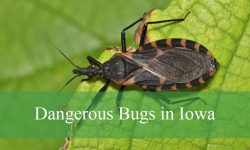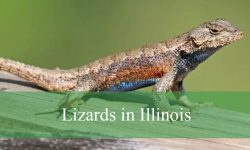Texas is home to some of the most fascinating water birds in North America, and kingfishers are among the most striking. With their large bills and vivid plumage, these birds are a favorite for birdwatchers exploring rivers, lakes, and coastal areas across the state.
The three kingfisher species found in Texas—Belted, Green, and Ringed Kingfishers—offer unique experiences for birders. Each species differs in size, coloration, behavior, and habitat preference, making identification both exciting and rewarding.
From the widespread Belted Kingfisher to the rare Ringed Kingfisher in South Texas, spotting these birds requires knowing their preferred environments and best viewing times. This guide will help you identify and enjoy all three species in their natural habitats.
Common Types of Kingfishers Found in Texas
Belted Kingfisher (Megaceryle alcyon)
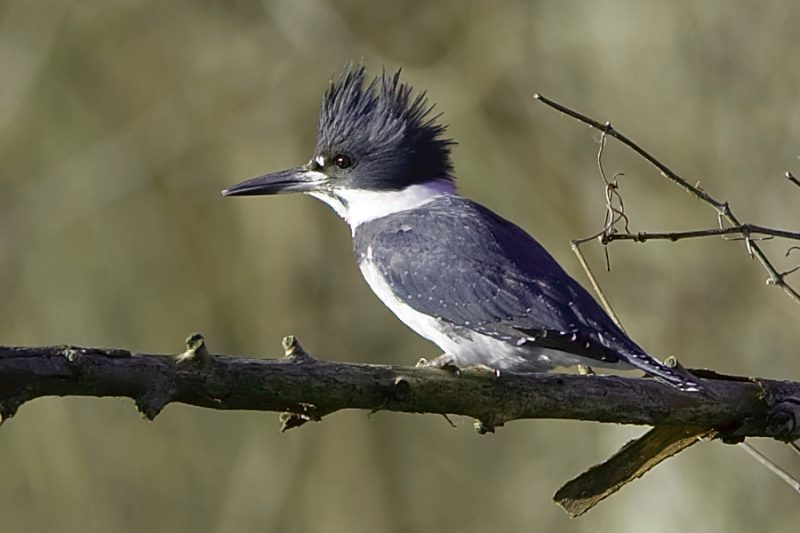
The Belted Kingfisher is the most widespread and easily recognized kingfisher in Texas. It is a medium-sized bird with a large, shaggy crest on its head and a long, dagger-like bill. Males are marked by a single blue-gray band across the chest, while females are slightly more colorful with an additional rusty band across the belly. Measuring about 11–14 inches in length with a wingspan of 19–23 inches, they are often seen perched along rivers and lakes, surveying the water below. Their rattling, mechanical call is another distinctive feature that helps birdwatchers identify them from afar.
These kingfishers are highly territorial and can often be spotted hovering briefly over the water before plunging straight down to snatch prey. Their diet is dominated by small fish, but they also feed on crustaceans, amphibians, and even small reptiles when available. They use their sharp bills to catch prey and often beat it against a perch to stun or kill before swallowing it whole. Their hunting style is both efficient and fascinating to observe, making them one of the iconic water-associated birds of Texas.
In terms of behavior, Belted Kingfishers are solitary outside of the breeding season. During nesting, they dig long burrows into sandy banks along rivers or lakes, sometimes extending 6–8 feet in length. Both males and females contribute to excavating the nest tunnel and raising the young. This burrowing habit makes them dependent on specific habitats with vertical, sandy banks suitable for nesting.
Across Texas, Belted Kingfishers can be seen throughout the year, but they are especially common during winter months when birds from farther north migrate south. They are widespread in both eastern and western parts of the state, inhabiting rivers, ponds, reservoirs, and coastal estuaries. Their adaptability to both freshwater and saltwater environments ensures that they remain a common sight wherever bodies of water provide ample fish.
Green Kingfisher (Chloroceryle americana)
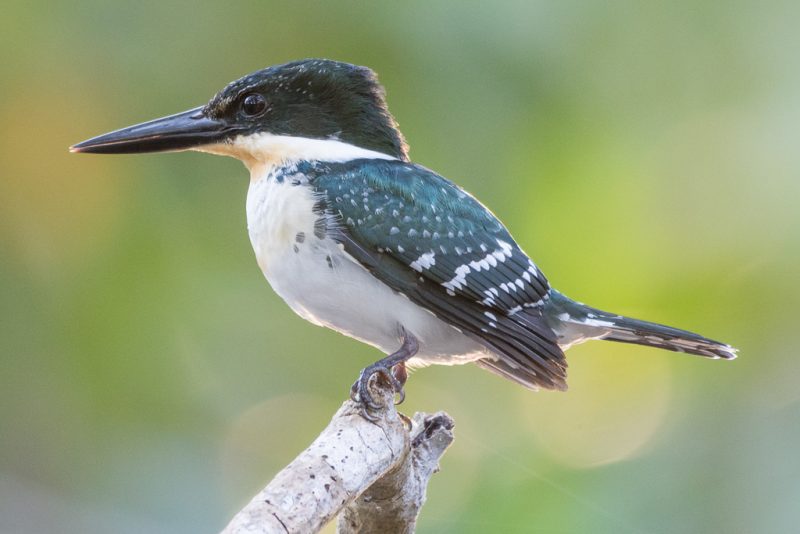
The Green Kingfisher is a smaller and more secretive species compared to its Belted cousin. At just 7–8 inches in length, it has a compact body with short wings and a long bill. Its upperparts shimmer with an iridescent green sheen, while the underparts are white. Males are easily distinguished by their broad chestnut band across the breast, whereas females have green spotting across the chest. This subtle sexual dimorphism helps birdwatchers differentiate between the sexes during field observations.
This kingfisher prefers quieter streams and rivers with dense vegetation along the banks. It usually hunts from low perches close to the water, darting out swiftly to capture fish or aquatic insects. Unlike the Belted Kingfisher, it does not hover frequently over the water but relies on ambush-style hunting. Its diet consists mainly of small fish, but it will also take insects and occasionally crustaceans.
Behaviorally, the Green Kingfisher is less conspicuous and far quieter than the Belted Kingfisher. It emits a sharp, ticking call, usually when flushed from its perch. These birds are territorial and typically found singly or in pairs. Like other kingfishers, they excavate nest tunnels into earthen banks, though their burrows are shorter than those of the Belted Kingfisher. Both parents participate in caring for the nestlings, feeding them a steady supply of fish.
In Texas, the Green Kingfisher’s distribution is limited mostly to the southern portions of the state, especially along the Rio Grande Valley and southern rivers. They are considered resident birds in these regions, meaning they do not migrate long distances. Their restricted range makes them a special sighting for birdwatchers in Texas, who often travel south specifically to catch a glimpse of this striking little kingfisher.
Ringed Kingfisher (Megaceryle torquata)
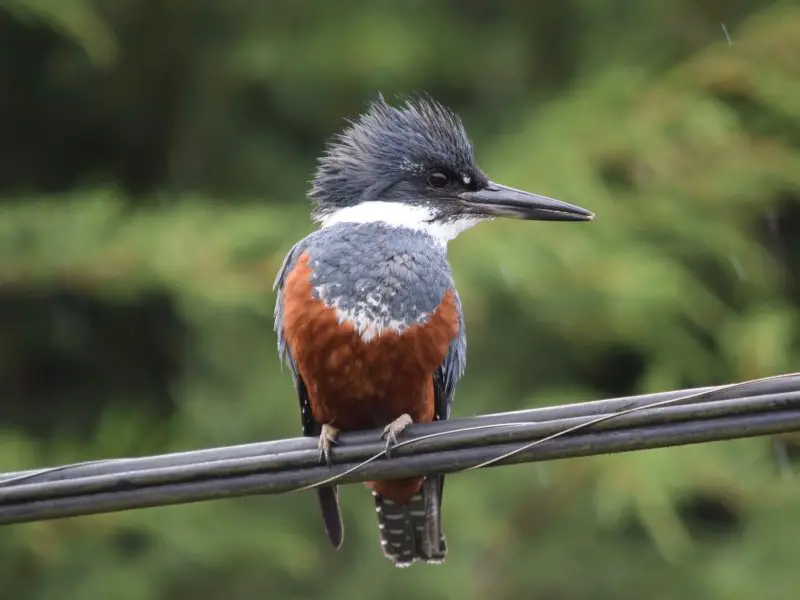
The Ringed Kingfisher is the largest kingfisher found in Texas and one of the most impressive in the Americas. Measuring 15–17 inches long with a wingspan of nearly 25 inches, it dwarfs both the Belted and Green Kingfishers. Its plumage features a bluish-gray back, a massive bill, and a distinctive rusty-red belly. Both males and females share similar plumage, though females tend to be slightly duller. The bird’s loud, rolling call carries over long distances, often alerting observers to its presence before it comes into view.
This species is a powerful hunter and relies heavily on fish as its primary food source. It is often seen perched on trees or wires overlooking rivers and lakes before diving headfirst into the water. Its large size allows it to capture bigger prey than other kingfishers, including sizable fish and even amphibians. Once caught, the prey is stunned against a perch and swallowed whole, just as with its relatives.
Ringed Kingfishers are less common and more localized than the other two species in Texas. They are highly territorial and often aggressive toward other kingfishers, chasing intruders away from their hunting grounds. During breeding, they excavate long burrows in earthen banks, where they raise their young. Both sexes share in incubation and feeding duties, making them devoted parents despite their otherwise solitary nature.
In Texas, this species is largely confined to the Rio Grande Valley in the southernmost parts of the state. They are more widespread further south into Mexico, Central, and South America, but only a few pairs consistently inhabit Texas rivers. Their rarity in the United States makes them a prized find for birdwatchers. Spotting a Ringed Kingfisher along the Rio Grande is considered one of the highlights of birding in South Texas, as it is the only region in the country where the species is regularly seen.
Best Time and Places to See Kingfishers in Texas
Texas is a rewarding state for spotting kingfishers, offering both widespread and highly localized opportunities depending on the species. The Belted Kingfisher is by far the most common and can be found almost anywhere there is water. Lakes, reservoirs, rivers, ponds, and even coastal estuaries across the state provide excellent chances to see them. They are most active during early mornings and late afternoons when fishing is best. Winter is an especially good season to spot them because northern birds migrate into Texas, increasing their numbers.
The Green Kingfisher requires more patience and a trip farther south. The best places to observe this species are in the Rio Grande Valley, particularly along quiet stretches of the Rio Grande and its tributaries. Refuges such as Santa Ana National Wildlife Refuge and Bentsen-Rio Grande Valley State Park are excellent hotspots. They are year-round residents in South Texas, but you’ll have the best luck in spring and summer when water levels are stable and vegetation along streams offers them perfect hunting grounds.
For the Ringed Kingfisher, birders must again head to the Rio Grande Valley. This species is most reliably seen along the Rio Grande near Laredo, Brownsville, and McAllen. Parks such as Falcon State Park and Estero Llano Grande State Park are known sites where they have been recorded. They are present throughout the year, but early mornings provide the best chance to hear their loud, rolling call echoing over the river before they come into view.
Overall, the prime time for kingfisher watching in Texas is from fall through spring, when Belted Kingfishers are plentiful and the southern species are active along the Rio Grande. By targeting waterways and refuges in southern Texas, birdwatchers can maximize their chances of seeing all three kingfisher species, making the region one of the most rewarding birding destinations in the United States.
FAQs about Kingfishers in Texas
What is the most common kingfisher in Texas?
The most common kingfisher in Texas is the Belted Kingfisher (Megaceryle alcyon). This species can be found across nearly the entire state wherever there are lakes, rivers, ponds, or coastal waters. Its loud rattling call and habit of hovering over the water before diving make it easy to spot, especially in winter when their numbers increase due to migration from northern states.
Where can I see Green Kingfishers in Texas?
Green Kingfishers are more restricted in range and are primarily found in South Texas, especially along the Rio Grande and its tributaries. Wildlife refuges such as Santa Ana National Wildlife Refuge, Bentsen-Rio Grande Valley State Park, and Estero Llano Grande State Park are among the best places to look for them. They prefer quiet streams and shaded riversides rather than open lakes.
Are Ringed Kingfishers rare in Texas?
Yes, the Ringed Kingfisher is considered rare in the United States and is only regularly found in the Rio Grande Valley of South Texas. This large and powerful kingfisher is often spotted near Falcon State Park, along the Rio Grande near Laredo, and occasionally around Brownsville and McAllen. Birdwatchers often travel specifically to this region to see this species, as it is the only place in the country where it reliably occurs.
What do kingfishers eat in Texas?
Kingfishers in Texas primarily eat fish, which they catch by diving headfirst into the water. However, their diets vary by species. The Belted and Ringed Kingfishers often take larger fish and sometimes amphibians or crustaceans, while the smaller Green Kingfisher also feeds on aquatic insects and tiny fish. All species use their sharp bills to capture and then beat their prey against a perch before swallowing it whole.
When is the best time of year to see kingfishers in Texas?
The best time to see kingfishers in Texas depends on the species. Belted Kingfishers are present year-round but are most abundant in winter when northern birds migrate south. Green Kingfishers and Ringed Kingfishers are resident species in South Texas, so they can be seen year-round, though early mornings in spring and summer often provide the best opportunities to spot them actively hunting.

